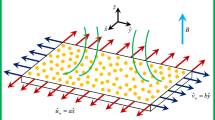Abstract
When a microorganism begins swimming from rest in a Newtonian fluid such as water, it rapidly attains its steady-state swimming speed since changes in the velocity field spread quickly when the Reynolds number is small. However, swimming microorganisms are commonly found or studied in complex fluids. Because these fluids have long relaxation times, the time to attain the steady-state swimming speed can also be long. In this article we study the swimming startup problem in the simplest liquid crystalline fluid: a two-dimensional hexatic liquid crystal film. We study the dependence of startup time on anchoring strength and Ericksen number, which is the ratio of viscous to elastic stresses. For strong anchoring, the fluid flow starts up immediately but the liquid crystal field and swimming velocity attain their sinusoidal steady-state values after a time proportional to the relaxation time of the liquid crystal. When the Ericksen number is high, the behavior is the same as in the strong-anchoring case for any anchoring strength. We also find that the startup time increases with the ratio of the rotational viscosity to the shear viscosity, and then ultimately saturates once the rotational viscosity is much greater than the shear viscosity.
Graphical abstract

Similar content being viewed by others
References
E. Lauga, T.R. Powers, Rep. Prog. Phys. 72, 096601 (2009).
D.A. Gagnon, N.C. Keim, P.E. Arratia, J. Fluid Mech. 758, R3 (2014).
M. Molaei, M. Barry, R. Stocker, J. Sheng, Phys. Rev. Lett. 113, 068103 (2014).
J. Li, S. Sattayasamitsathit, R. Dong, W. Gao, R. Tam, X. Feng, S. Ai, J. Wang, Nanoscale 6, 9415 (2014).
B.J. Williams, S.V. Anand, J. Rajagopalan, M.T.A. Saif, Nat. Commun. 5, 3081 (2014).
Y. Magariyama, S. Sugiyama, K. Muramoto, I. Kawagishi, Y. Imae, S. Kudo, Biophys. J. 69, 2154 (1995).
H.C. Berg, Ann. Rev. Biochem. 72, 19 (2003).
R. Kamiya, E. Hasegawa, Exp. Cell Res. 173, 299 (1987).
B.H. Gibbons, I.R. Gibbons, J. Cell Biol. 54, 75 (1972).
D.J. Smith, E.A. Gaffney, H. Gadêlha, N. Kapur, J.C. Kirkman-Brown, Cell Mot. Cytos. 66, 220 (2009).
X.N. Shen, P.E. Arratia, Phys. Rev. Lett. 106, 208101 (2011).
O.S. Pak, E. Lauga, Proc. Roy. Soc. 466, 107 (2010).
B. Liu, T.R. Powers, K.S. Breuer, Proc. Natl. Acad. Sci. U.S.A. 108, 19516 (2011).
A. Gilboa, A. Silberberg, Biorheology 13, 59 (1976).
S.K. Lai, Y.Y. Wang, D. Wirtz, J. Hanes, Adv. Drug Deliv. Rev. 6, 86 (2009).
G.J. Elfring, E. Lauga, Theory of locomotion through complex fluids, in Complex fluids in biological systems, edited by S.E. Spagnolie (Springer, Berlin, 2015).
S. Zhou, A. Sokolov, O.D. Lavrentovich, I.S. Aranson, Proc. Natl. Acad. Sci. U.S.A. 111, 1265 (2014).
P.C. Mushenheim, R.R. Trivedi, H.H. Tuson, D.B. Weibel, N.L. Abbott, Soft Matter 10, 88 (2014).
M.S. Krieger, S.E. Spagnolie, T.R. Powers, arXiv:1507.00776 (2015).
G.I. Taylor, Proc. R. Soc. Lond. Ser. A 209, 447 (1951).
L. Xie, T. Altindal, S. Chattopadhyay, X.L. Wu, Proc. Natl. Acad. Sci. U.S.A. 108, 2246 (2011).
S.F. Goldstein, J. Cell Biol. 80, 61 (1979).
P.G. de Gennes, J. Prost, The Physics of Liquid Crystals (Oxford University Press, Oxford, 1995) 2nd edition.
M.S. Krieger, S.E. Spagnolie, T.R. Powers, Phys. Rev. E 90, 052503 (2014).
L.D. Landau, E.M. Lifshitz, Theory of elasticity (Pergamon Press, Oxford, 1986) 3rd edition.
R.G. Larson, The structure and rheology of complex fluids (Oxford University Press, New York, 1999).
M. Abramowitz, I.A. Stegun, Handbook of Mathematical Functions (Dover Publications, Inc., New York, 1964).
B. Davies, B. Martin, J. Comput. Phys. 33, 1 (1979).
Author information
Authors and Affiliations
Corresponding author
Rights and permissions
About this article
Cite this article
Krieger, M.S., Dias, M.A. & Powers, T.R. Minimal model for transient swimming in a liquid crystal. Eur. Phys. J. E 38, 94 (2015). https://doi.org/10.1140/epje/i2015-15094-3
Received:
Revised:
Accepted:
Published:
DOI: https://doi.org/10.1140/epje/i2015-15094-3




